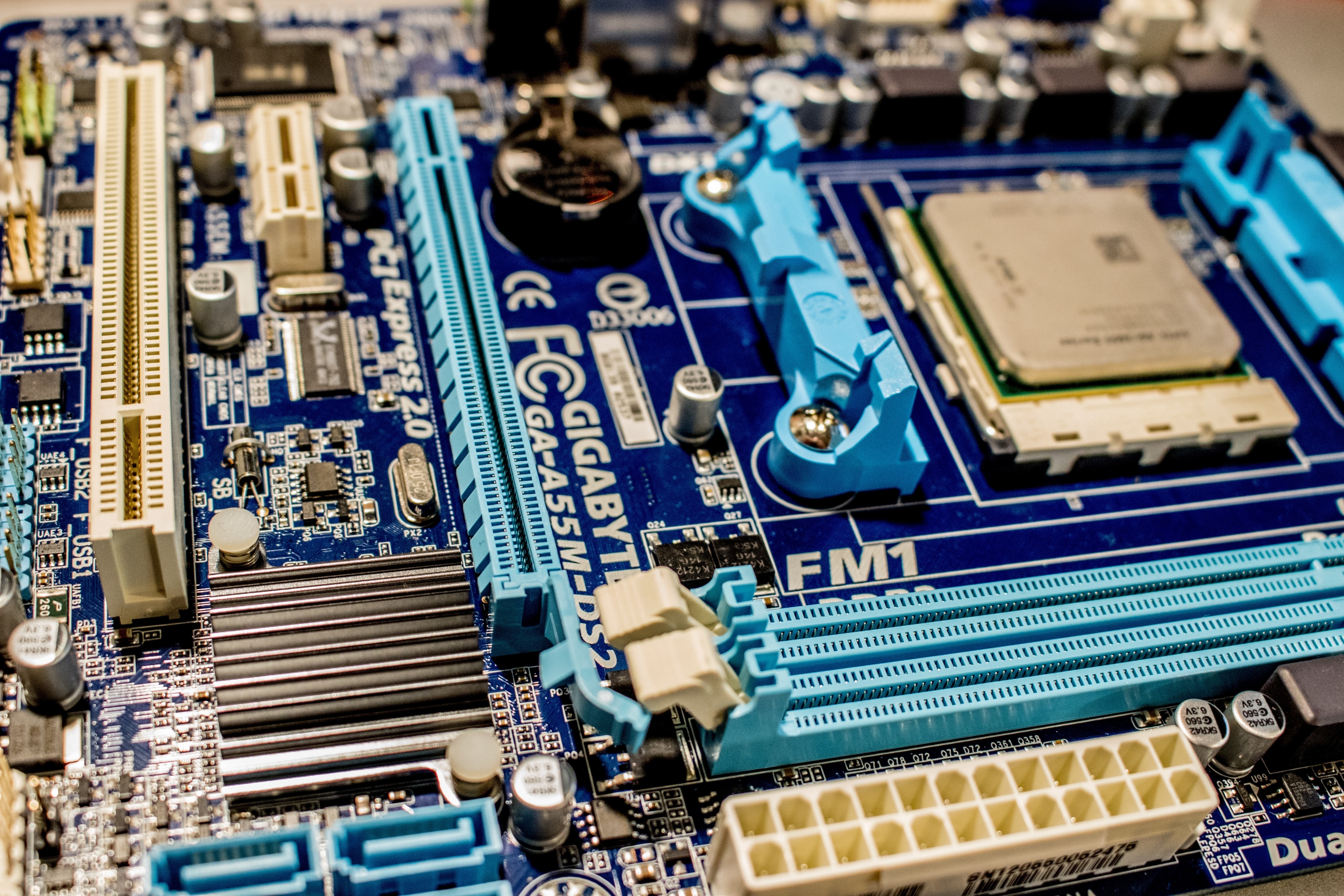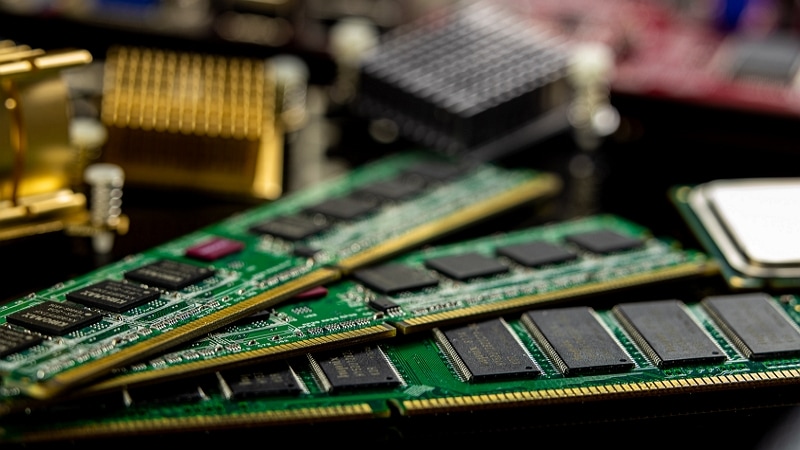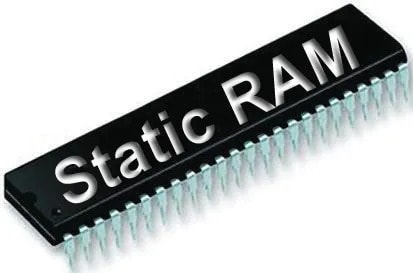All the latest digital devices such as PC, laptops, mobile phones, etc. perform three basic operations; input, processing, and output. For this purpose, every computer needs memory for storing data and information before and after processing. This is where the RAM (Random-Access Memory) comes into existence.
There is another very secret reason for using RAM. The CPU works on a very high frequency from 3.2 to 5.5 GHz. while the storage devices such as HDD (Hard Disk Drive) and USB Flash Drives work on a lower frequency. If the CPU tries to communicate with these devices, the devices will burn out. This is why an intermediary device, RAM, is used as a data transfer and communication media.
1. What Is RAM?
RAM stands for Random-Access Memory and it is the primary memory in computers, laptops, mobile phones, etc. This is a volatile memory device that not only stores the data and program instructions before and after the processing and I/O Operations but it is also a communication media between the processor and other devices.

The term volatile means that the contents of a RAM are erased as soon as the battery or power supply is switched off. You might be thinking what does it mean by Random-Access? It simply means that devices can access any part of the RAM, where data or instructions are stored using the address, instead of reading from the beginning as in the sequential memory devices. Usually, volatile RAMs are called DRAMS (Dynamic Random-Access Memory).
2. What Is The Purpose of RAM
Several reasons make the RAM an essential part of the computing devices. One of the primary purposes of RAM is the storage of temporary files that help different applications and programs run. Here we are going to discuss some of the primary functions of RAM.

Loading Operating System
When you start your laptop, PC, mobile phone, or any other device, it loads the operating system into the RAM first so we can use the device using a graphical user interface. By operating system, we mean Windows, macOS, Android, and iOS.
So the RAM holds most of the functionalities, services, and applications (apps) of the operating system that are continuously needed. The operating system leaves the RAM only when the device is shut down. But in the case of continuously running mobile phones and servers, the OS always remains inside the RAM.
Communication Channel between Processor and Other Devices
After some time new processors have developed that have ruled the market for decades. The frequency of processors is increasing along with their generation. For example, the fastest 12th Generation processor Core i9-12900KS can run at 5.5 GHz or even more hertz when turbo.
The processors with higher frequencies cannot be allowed to communicate with the devices with lower frequencies connected to the same device. As a result, the devices will burn out. This is where RAM takes place and works as a communication medium.
A Mandatory Part of Data Processing
All types of computers and most digital devices are capable of taking input from users, processing it, and providing us the result or information. This process is also termed “Data Processing”. It is RAM that not only holds the data so that the CPU (Central Processing Unit) can process it but it also holds the results so we can store them.
For example, if you want to add two numbers 23 and 7 using a calculator app then these numbers will be first stored inside your RAM using variables. After that, the ALU (Arithmetic and Logic Unit) in the CPU will add these numbers. In the end, the result will be stored inside the RAM so we can see it on our display monitor, store it on our SSD, and print it using our printer.
Storing I/O Requests and Results
RAMs are the memory modules that store Input/Output Requests and the output results. For example when you are playing a video game then you continuously give input using your controller, mouse, keyboard, etc. These inputs are stored in the RAM so that the processor can understand and act according to them. The responses of these inputs are also stored in the RAM so that they
Hold Program Instructions and Interrupt Requests
A program is defined as a set of instructions that can belong to either a system software or application software (AKA app). This is how our computing devices can work faster without even disturbing the processor at each request.
For example, if you open a word processing application software then a certain amount of RAM is allocated to it. The program instructions that are responsible for checking spelling and grammar mistakes are also loaded in the RAM. Similarly, nearly all kinds of interrupts are held by the RAM such as restarting a PC or Laptop.
Simultaneous Execution of Apps
Older computers were not as fast as modern ones. The credit not only goes to the operating systems and their scheduling techniques but also goes to the RAMs. Nowadays computers can install multiple RAMs with higher capacity and each RAM can hold multiple applications at the same time. Then the execution of these applications is scheduled in a certain order so we can run all of the software.
For example, if a video editor is assigned to edit a very high-quality video then they would be working on multiple applications at the same time such as video editor, image viewer, graphics card monitoring software, etc. And at the same time, there might be a web browser opened along with online storage and syncing application.
3. How Does RAM Work?
There are two types of RAMs; DRAM (Dynamic Random-Access Memory) and SRAM (Static Random-Access Memory). Most of the RAMs that are present in our personal computers and laptops are DRAMs. Hence, here we are going to elaborate on the working of DRAM in a very simple and easy language so you can clear your concepts about it RAMs:
Before understanding the working of a RAM you need to understand a very important electronic component named capacitor. The capacitor is the basic building block of DRAMs. Actually, the capacitor is a passive component that can store electric charge in the form of an electric field.

The capacitor used in digital circuits RAM has two terminals, one positive and the other negative. Using these terminals a capacitor can either be charged or be discharged. Computers can understand only Binary Language at a very low level. Hence a charged capacitor represents logic 1 and a discharged capacitor means logic 0. This is why these capacitors are called memory cells as they store digital data.
Now the RAMs consist of millions of capacitors and the circuit mechanisms for charging and discharging them. You might have Refreshed your computer or laptop many times but do you know when you refresh it you actually recharge the capacitors that were losing their electric field slowly. Yes, this is a drawback of RAMs but don’t you worry, there are circuits in your computer for automatically refreshing the RAMs.

There are address, data, and control buses connected to the RAM and all other components such as CPU, SSD, Keyboard, Mouse, etc. Using these buses data and instructions travel from RAM to these devices and vice versa. The RAMs have the address of each block for storing data and using this address the data and instructions can be stored and fetched directly. This is why RAMs are called Random-Access Memory.

If we need to add two numbers 7 and 3 using a calculator app on our computer then we first type them using a keyboard. Since the binary values of 7 and 3 are 00000111 and 00000011 so the relevant capacitors will be charged and discharged in such a manner. After that, the CPU will calculate the result that is 10 or 00001010 and send it back to the RAM so we can see it using our calculator app.
4. Different Types of RAM: DRAM vs SRAM
There are two main types of RAM that are discussed below:
- DRAM
- SRAM

What Is DRAM?
DRAM is an inexpensive and popular form of RAM. DRAM stands for Dynamic Random-Access Memory. The basic building blocks of a DRAM are capacitors. These capacitors are used as memory cells by charging and discharging them. Usually, transistors are connected to the capacitors for this purpose.

DRAMs are volatile meaning these RAMs lose their contents when the device is switched off. Actually, capacitors are electronic components with two terminals that can hold electric potential in the form of an electric field. A charged capacitor represents logic 1 while a discharged capacitor denotes logic 0. This is how a DRAM stores the Binary Language instructions at a very low level.
DRAM is called Dynamic because there is a flaw in using the capacitors as memory cells that they start to discharge with the passage of time. For retaining the contents of a DRAM these capacitors are charged again and again. This phenomenon makes this type of RAM the Dynamic or Active RAM. If you do not Refresh your computer then there are Refresh Circuits for performing this task automatically for you.
Pros and Cons of DRAM
Pros
DRAMs are cheaper than SRAMs.
DRAMs are compatible with most computers.
Each memory cell needs only one capacitor and one transistor.
DRAM provides a higher density level as much as 64 GB.
The architecture or design of DRAM is simple.
Cons
Capacitors in DRAM need continuous charging for retaining the contents. This is why these RAMs have low performance.
All DRAMs are volatile.
What Is SRAM?
SRAM stands for Static Random-Access Memory, which is another popular but expensive type of RAM. The basic building blocks of an SRAM are called Latches or Flip Flops. These Latches are made up of logic gates that can store binary data. Each latch can either store a logic 0 or 1.

SRAM is also a volatile memory as it loses its contents when the power is disconnected. These RAMs are called Static because the basic memory cells of SRAM do not need to recharge repeatedly as in the DRAM. The manufacturing cost of DRAMs is higher than DRAMS, so is their performance.
Pros
SRAM is the fastest RAM.
The performance of SRAMs is way better than DRAMs.
The cycle Time of SRAMs is shorter than DRAMs.
Speed-Sensitive-Cache can be created using SRAMs.
The power consumption of SRAMs is lower than DRAMs.
SRAM does not pause when accessing the data or instructions on it.
Cons
SRAMs are very expensive.
5. How Much RAM Do I Need?
Need of RAM for a computer, laptop, or mobile phone changes from user to user. A user who does simple tasks such as making presentations, reading, and writing, watching movies, etc does not need more than 4 GB RAM. But there are extreme users that need RAM installed according to their use:
RAM for Gamers and Steamers
The people who play video games and live stream them not only use a faster internet connection but also a higher RAM for smooth gameplay and streaming. Minecraft players should have more than 4 GB RAM, the GTA-V players must have at least 16 GB RAM, and PUBG players should install more than 8 GB RAM. On average, from 10 to 12 GB RAM will play all of the games present nowadays.
RAM for 3D Artists and Renderers
Most of the 3D Artists use Blender and Maya 3D for rendering their pieces of art. Software like these require at least 8 GB RAM but it is recommended to install from 2 to 4 GB more as the Operating System and temporary results are also stored in RAMs. The rest is left for the VRAMs that are present on the Graphic Cards with GPUs.
RAM for Video Editors and Renderers
Movie editors, especially the ones who merge 3D characters and scenes with videos, need RAM from 16 to 32 GB. It depends on the software and the Graphics Card they are using. And it also depends if they have multiple monitors with multiple applications opened on them. For small businesses, 32 GB RAM is enough.
RAM for Game Developers
Unity and Unreal engine are top 3D games building engines but there is also an abundance of these types of software. For 2D game developers, 8 GB RAM is enough but for 3D game development, it depends on the game itself. If the game is low poly, then 8 GB RAM will do. If the game is medium quality a mix of low poly and high-quality textures then 12 GB RAM is enough. For developing realistic games at least 16 GB of RAM is required.
6. What’s The Difference Between RAM, ROM, and General Storage?
All three of these are usually installed inside computers, laptops, mobile phones, and other intelligent devices:
RAM
RAM (Random-Access Memory) is a volatile memory whose contents are erased automatically as the device it is installed in shuts down. RAM holds data and program instructions for the CPU (Central Processing Unit) to perform processing operations on. It also stores the results of those operations but all of this is temporary and is erased after the work is done.
Pros and Cons of RAM
Pros
RAM is the only memory in devices that can be directly accessed by the processor.
RAM is way faster than secondary storage such as HDD or USB Flash Drives.
RAM stores the data before processing and it also holds the information or results after processing.
RAM gives place to the application programs (apps) when those are executing.
RAM can read and write almost all kinds of data such as audio, video, images, text, etc.
RAM increases the speed of the device it is installed in.
RAMs do not have mechanical parts that make noise or spin at high speed.
Cons
Being volatile memory is a disadvantage of RAM.
RAMs are small in capacity and bigger ones are expensive.
ROM
ROM (Read Only Memory) is a type of memory whose contents can only be viewed or read such as CD-ROM (Compact Disc ROM). But there are types of ROM that allow you to erase their previous contents and write the new ones such as EEPROM. ROMs are non-volatile memories meaning that the data and programs are stored permanently inside them even when the ROMs are not connected to any power source. Learn more about what is ROM.
General Storage
The storage is installed on almost all kinds of latter devices for permanently storing the data. This feature of storage is also known as non-volatility. Prominent storage devices include HDD (Hard Disk Drive), SSD (Solid State Drive), M2 Modules, USB Flash Drives, etc.
RAM Market and Trends
From computer manufacturers to mobile producers, most companies manufacture their own RAM chips to reduce the external cost. These companies are spread over the globe to provide their services to end-users. There is a list of manufacturers who develop RAMs. We are providing you with the top manufacturers only:
- Samsung
- SK Hynix
- Longsys
- Corsair
- ADATA Technology Co.
- AOpen
- Micron
- Arch Memory
- Lenovo
- Intel
- Billionton Systems
However, it is not about the company whose RAM will make your computer faster, it is about the total RAM installed in it. More RAMs mean faster the device and less RAMs mean slower the hardware.
People Also Ask
What is RAM used for in a computer?
RAM (Random-Access Memory) is a fundamental part of every computer. No computer can work without RAM as it temporarily stores data to be processed and the result of processing. RAM is also responsible for loading the operating system such as Windows and MacOS and other application software.
Is 8 GB RAM enough?
Yes, if you work on small video editing, gaming, character modeling, 2D or low poly 3D game development projects. But if you want to do the same projects on a higher level using multiple monitors then you should consider upgrading your total RAM capacity.
What are the three types of RAM?
Three types of RAM are DRAM (Dynamic RAM), SDRAM (Synchronous Dynamic RAM) and SRAM (Static RAM).
Is 4 GB RAM enough for Windows 10?
Yes, 4 GB RAM is enough for Windows 10 but if you want to do tasks like gaming, rendering, and game development then you should have at least 8 GB RAM.
Which RAM is used in Laptops?
Laptops have the same RAMs as the ones in our desktop computers meaning 4 GB, 8 GB, 16 GB, etc but the only difference is that those RAMs are small in size physically.
Who are the major manufacturers of RAM?
Samsung and HK Hynix are on the top when it comes to manufacturing RAMs. But Longsys, Corsair, ADATA Technology Co., AOpen, Micron, Arch Memory, Lenovo, Intel, Billionton Systems, etc are also in the queue.
What type of memory is RAM?
RAM (Random-Access Memory) temporarily stores the apps and data that is currently used in your computer, laptop, or mobile phone. It is a volatile memory meaning that it loses its contents when your device is switched off.
Conclusion
This article is a very easy and descriptive guideline about RAMs in our computers, mobile phones, laptops, etc. For you, we have defined the term RAM with different essential perspectives. This guideline also includes the basic building blocks and working of RAMs.
Along with the functions and importance of RAM, you will also learn about the two types of RAMs - DRAM and SRAM. You will not only learn the pros and cons of RAM and its Types but also the fact that how much RAM you should install on your computer or laptop. You are provided a list of top manufacturers of RAM with the FAQs about Random-Access Memory.

 ChatGPT
ChatGPT
 Perplexity
Perplexity
 Google AI Mode
Google AI Mode
 Grok
Grok























